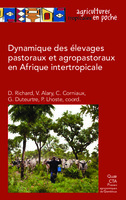Dynamique des élevages pastoraux et agropastoraux en Afrique intertropicale
Contributor(s)
Richard, Didier (editor)
Alary, Véronique (editor)
Corniaux, Christian (editor)
Duteurtre, Guillaume (editor)
Lhoste, Philippe (editor)
Language
FrenchAbstract
De 1974 à 2014, l’Afrique intertropicale a connu une croissance inédite des effectifs des herbivores domestiques. Les effectifs bovins ont été multipliés par plus de 2, ceux des petits ruminants par plus de 3. Aujourd’hui, la région regroupe environ 20 % des bovins et des ovins, 33 % des caprins et 81 % des dromadaires élevés sur la planète. Soit un cheptel de près de 900 millions de têtes. L’ouvrage est axé sur la dynamique des élevages des ruminants et des équidés en Afrique intertropicale. Il décrit les différents systèmes d’élevage rencontrés en zones aride et subhumide et les ressources alimentaires disponibles ; il aborde les impacts locaux et globaux des élevages des herbivores sur l’environnement. Le rôle socio-économique majeur des activités autour des animaux et de leurs produits, et la demande croissante en viande et lait des consommateurs sont soulignés. Une organisation efficace des filières bétail-viande est rapportée, alors que des contraintes à la mise en place d’une industrie laitière persistent. Pour de nombreuses familles vivant proches du seuil de pauvreté, l’élevage est un facteur de réduction de la vulnérabilité. Divers services qui permettraient un développement durable des élevages sont décrits. Cependant, les modes de financements et les suivis des impacts socio-économiques et environnementaux devront évoluer.
Keywords
sustainable development; Africa; rural development; animal production; dairy products; animal husbandry; water resources; environment; food security; cattle; goats; farming; sheep; technical advice; fodder; animal pathology; pasture; poultry; zootechnics; ruminantDOI
10.35690/978-2-7592-2895-9ISBN
9782759228959OCN
1147278902Publisher
éditions QuaePublication date and place
2019Classification
Tropical agriculture


 Download
Download